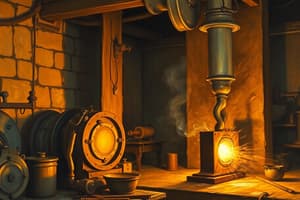Podcast
Questions and Answers
What is the formula for calculating buoyant force in the context of casting?
What is the formula for calculating buoyant force in the context of casting?
P=V(ρ - d)
Why are chaplets used in casting?
Why are chaplets used in casting?
Chaplets are metallic supports used to support the cores inside the mould cavity.
What can be a problem associated with chaplets in casting?
What can be a problem associated with chaplets in casting?
The condensation of moisture, leading to blow holes.
Why is it important to thoroughly clean chaplets before placing them in the mould?
Why is it important to thoroughly clean chaplets before placing them in the mould?
What is the suggested action to avoid problems with chaplets in casting?
What is the suggested action to avoid problems with chaplets in casting?
What is the purpose of chaplets before they are placed in the mould?
What is the purpose of chaplets before they are placed in the mould?
What are some types of chaplets commonly used in casting?
What are some types of chaplets commonly used in casting?
Why is it difficult to achieve a strong joint between chaplets and the parent metal?
Why is it difficult to achieve a strong joint between chaplets and the parent metal?
What is the role of the molten metal in relation to chaplets during solidification?
What is the role of the molten metal in relation to chaplets during solidification?
How can the required chaplet area be calculated?
How can the required chaplet area be calculated?
Study Notes
Metal Casting Processes
- Metal casting processes are divided into two categories based on mold type: expendable mold and permanent mold.
- Expendable mold casting operations involve sacrificing the mold to remove the cast part, e.g., sand casting.
Mold Making
- A mold is a cavity or impression in the molding sand, produced by a pattern.
- The process of producing this cavity is known as "moulding".
Composition of Molding Sand
- The principal constituents of molding sand are silica sand, binder, additives, and water.
- Silica sand is the main constituent, imparting permeability, chemical resistivity, and refractoriness to the molding sand.
- Binder (clay) imparts sufficient strength and cohesiveness to the molding sand.
- Water quantity in molding sand varies from 2 to 8 percent.
- Additives (e.g., coal dust, wood flour, molasses, corn flour, and pitch) improve existing properties or introduce new properties to the molding sand.
Types of Molding Sand
- Green sand: a mixture of silica sand with 18 to 30 percent clay, having 6 to 8 percent water content, used for small and medium castings.
- Dry sand: green sand with removed moisture, used for large castings.
- Facing sand: used directly next to the surface of the pattern.
Cores
- Cores must possess strength, permeability, heat resistance, and collapsibility.
- Cores are made of sand aggregates and are anchored by core prints, which provide vents for gas escape.
- Common problems with cores include lack of structural support in the cavity.
- Metal supports (chaplets) may be used to anchor the core in place.
Types of Cores
- Horizontal core: the most common type, assembled in the mold with its axis horizontal.
- Vertical core: similar to a horizontal core, but fitted in the mold with its axis vertical.
- Balanced core: used to produce a blind hole along a horizontal axis, supported only on one end.
- Hanging or Cover Core: hangs vertically in the mold with no support at its bottom.
Studying That Suits You
Use AI to generate personalized quizzes and flashcards to suit your learning preferences.
Description
Explore the process of core making in foundry technology, including the importance of strength, permeability, heat resistance, and collapsibility in cores. Learn about core prints, their role in anchoring and supporting cores, and providing gas vents. Test your knowledge on common issues faced with cores in casting processes.




